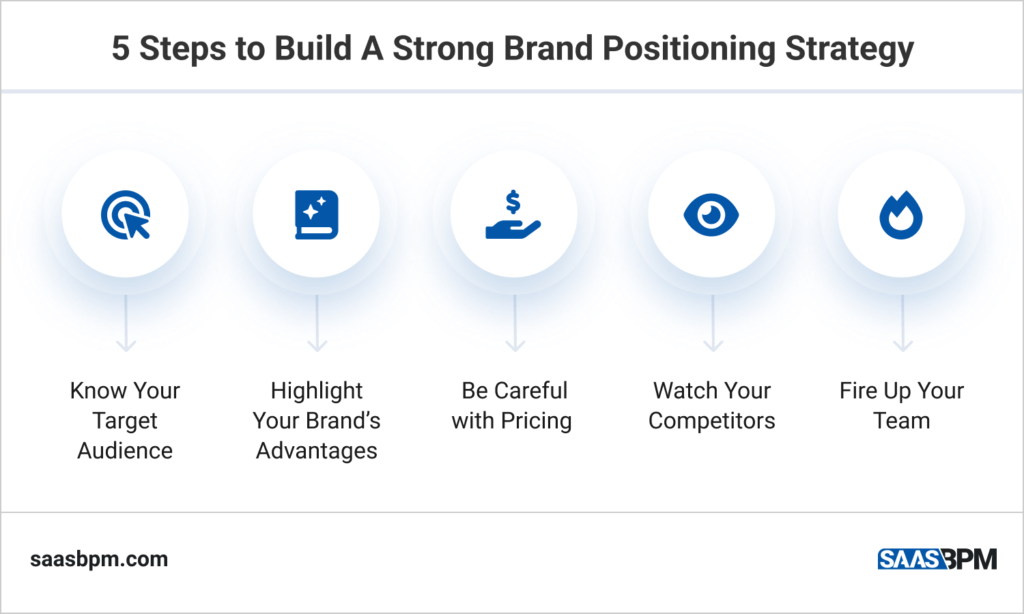A brand positioning strategy is a process of building a short, concise statement that communicates the attributes to your brand and sets it apart. You may have a reliable, high-quality product but making sure you position it well on the market is what will set you for success.
The business world is saturated and it is quite unlikely to find a niche that no company has targeted. Therefore, finding a competitive advantage and conveying it in a short, simple yet exciting way is essential for a strong brand positioning strategy.
In this article, we will first elaborate more on why communicating a strong positioning statement is important. After that, we will explain what the difference between a brand positioning strategy and defining a unique selling proposition (USP) is. Then, we will go ahead and suggest 5 surefire steps to establish a statement with your brand.
Why Does Brand Positioning Matter?

A strong brand positioning strategy is the driving force for a well-known brand. It is integral in the marketing process because it relates to all aspects of a company’s reputation.
Well-positioned brands can lead to significant opportunities for success. Of course, this largely depends on how well the brand connects with its customers and ultimately resonates their needs.
Your brand positioning statement is what would make someone prefer you over another business that offers a similar product or service. Thus, make sure your strategy is consistent and identifiable. After all, if you convince your audience you know their pains and have the right solution, you will surely build a strong following of brand advocates preaching your message along.
Company brand positioning is difficult, but if you get it right, the customers will know why to buy from your company instead of someone else. In order for a successful brand campaign it’s important that companies target their audience correctly. This way they can plan how to distribute their resources and diminish loopholes in the process.
Brand Positioning vs. USP
Brand positioning is essentially a combination of your company culture, promise, corporate values and public image. On the other hand, a USP is a statement that reflects why likely customers should make the purchase. So, in a way, USP is what comes after a brand positioning statement.

To be successful, a business must not only create innovative products, it must also communicate to customers how those products are better than the competition. This is called a brand positioning strategy. The company’s values, mission and culture must be distilled into one word that represents the key benefit of the product. This is what will make customers want to buy it.
A product’s sales revenues are determined in part by how well a company can convince people that the product has a particular benefit. This is called a USP, and it is something that a company’s advertising focuses on. This way, they can convince more people to buy the product, and make more money. For example, “clear, mistake-free writing” is a unique selling proposition for Grammarly, which appeals to people who want to increase the quality of their writing quickly.
5 Steps to Build A Strong Brand Positioning Strategy
Building a strong brand positioning strategy is a crucial component of product marketing. It’s what differentiates your brand from others and sets it apart in the minds of consumers. However, there are many strategies to craft successful positioning messages without being too general or vague about key features. So let’s get down these 5 steps to successfully position your brand in the market.

Determine Your Target Audience
Your target audience is the specific group of people you want to sell your product or service to. You need a clear understanding and knowledge about what their profiles look like, their language, age, preferences etc.
It is not enough to understand the problems your audience is facing. Simply pointing them out to them will not help them solve them. So, once you determine your ideal customer, start strategizing on ways to offer solutions that will make them trust you with their pain points.
Emphasize Your Brand’s Advantages
Companies are always looking for ways to stand out. You should take this into account when developing your brand identity. A good place to start would be analyzing your strengths/weaknesses as well as future goals.
For a successful brand positioning strategy, you need to identify what makes your business unique. Hence, it’s not just about what you do – it’s how well and quickly you take to deliver results. Does your team always meet the deadline? Then mention that in ads or taglines if they’re relevant for potential customers. Make sure to position yourself based on one particular strength of yours you decide to stress on.
Tailor Price To Value
The type of brand and added value you create will justify the price, and your audience buys into that. So, pricing your product or service corresponds to how you position your brand.
If you sell luxury, boutique services, you may only have a few high-quality items at a higher price range. On the other hand, if you position your brand as affordable and easy to use/implement, then make sure you ask for a standard, low fee.
For example, our product is a cloud-based easy-to-use BPM system that helps companies be more efficient with their workflows. So, SaaS BPM offers 4 different pricing plans, each matching a certain business size and set of services. Therefore, you need to find a price that matches how much people are willing to spend.
Indulge In Competitor Analysis

Brands should try to be different from the competition by filling in gaps and distinguishing themselves. First, look online to see who your competitors are. Look at their websites and social media presence to understand how they market themselves.
Then, try to figure out what makes your company different and better than other brands in your niche. Build a brand positioning strategy that sets you as the better alternative. For example, Aldi UK bluntly advertises how much their prices are lower than their counterparts on particular products. So, make sure you keep a close eye to your competitors to be able to beat them at what you bring to the table.
Preach Your Brand Positioning Strategy To Your Team
What is a brand positioning strategy without a team who identifies with it all the way? Make sure you spread your company core values, business advantages and brand mission statement into all business processes, at all levels within your organization.
Your brand is your personality, and it shines most when everyone on the team shares in its values. When customers experience a consistent message from you about what makes them special and see their problems met with care and consideration on your end, you are on your way to be a rockstar within your market.
Wrapping Up
If you want to create a successful brand positioning strategy, it’s important to have a clear and concise statement that communicates the unique attributes of your business. SaaS BPM can help you convey your positioning statement quickly and efficiently across your team, so they can advocate for your strengths and competitive advantages in your field. So, make sure to explore your target audience, define the benefits you have to offer, monitor your competitors closely and stay reasonable with pricing.

